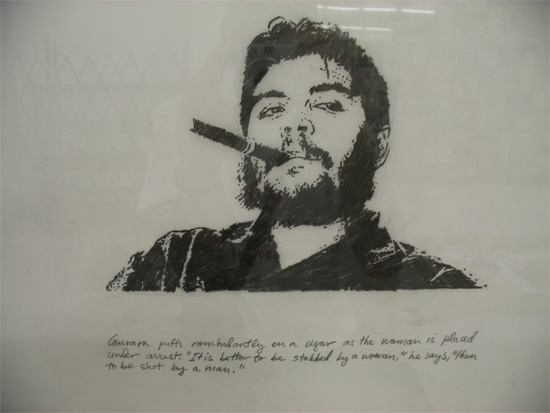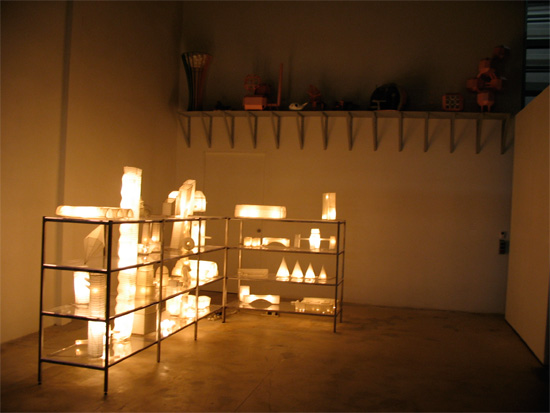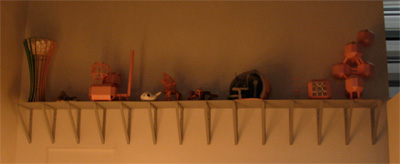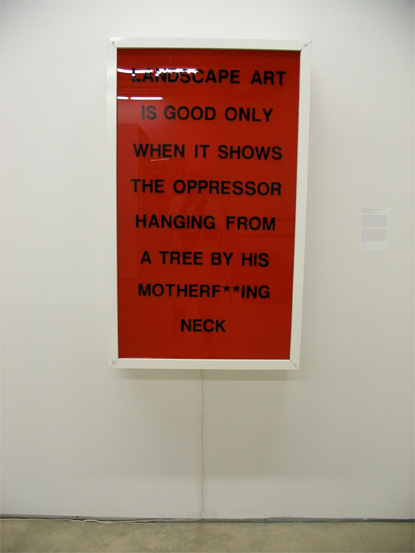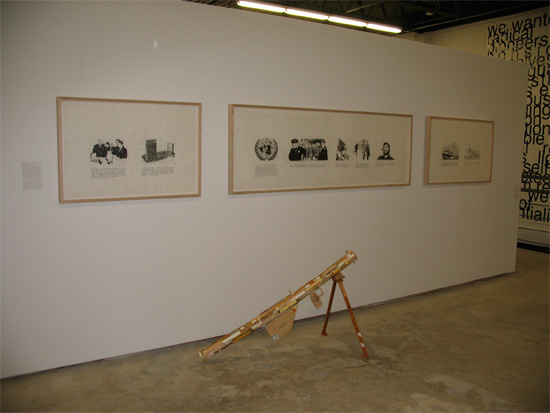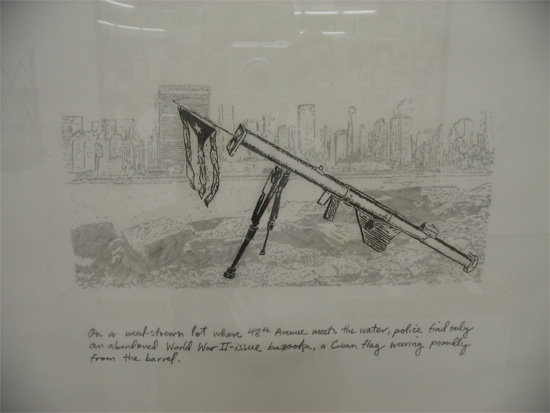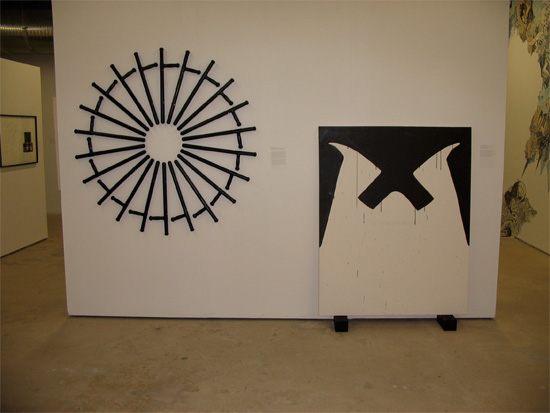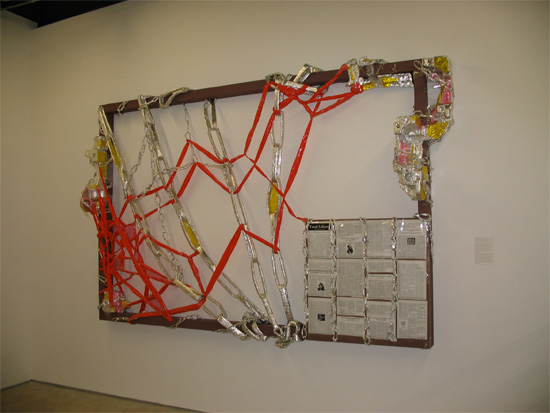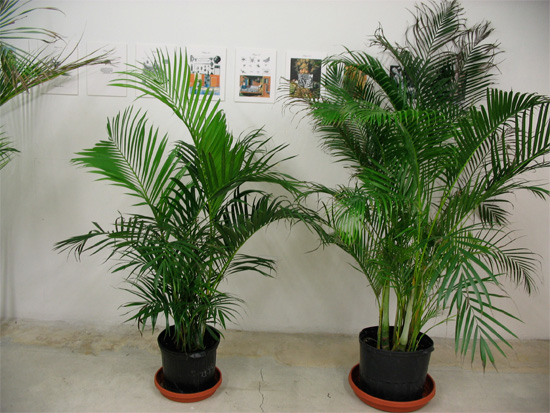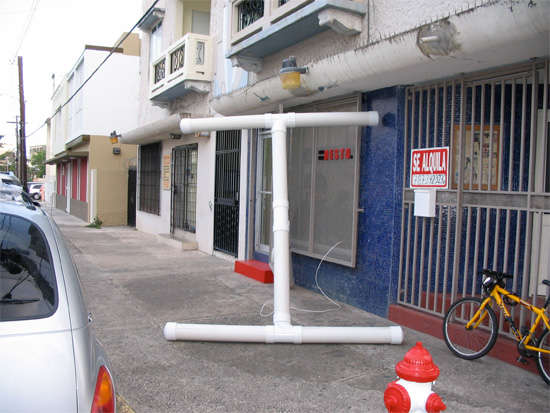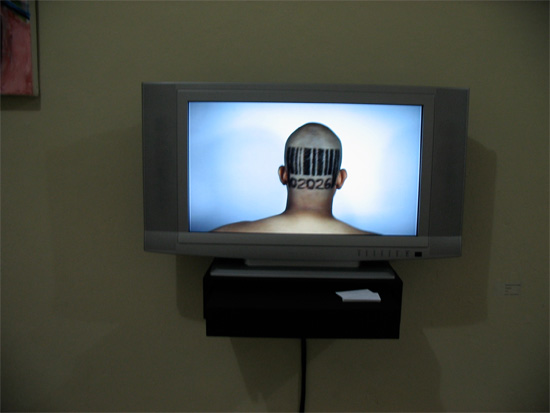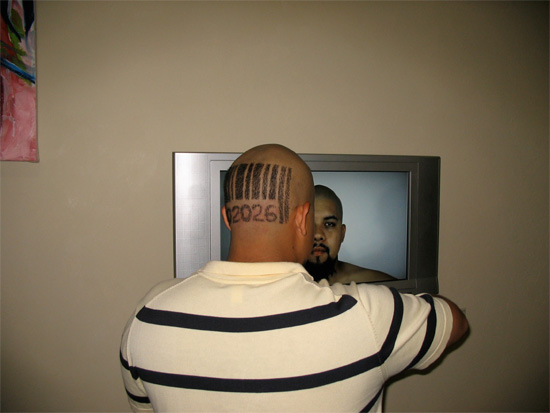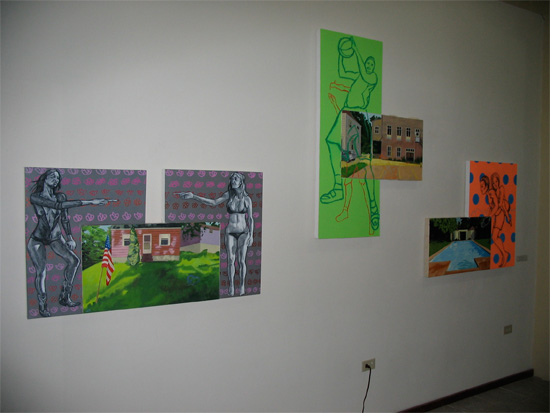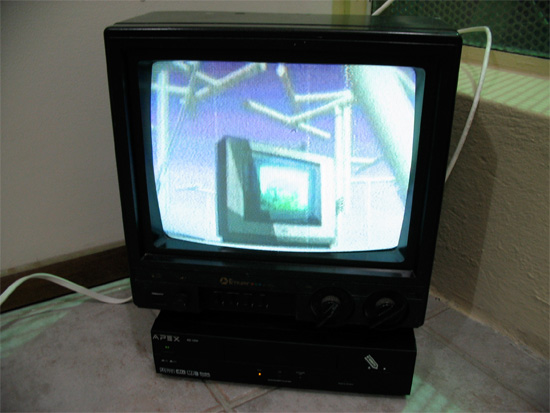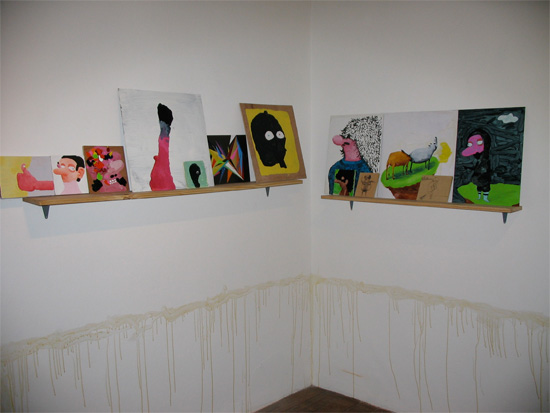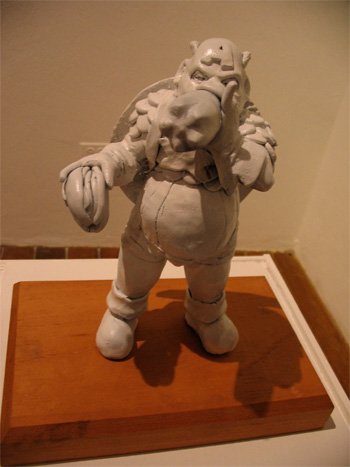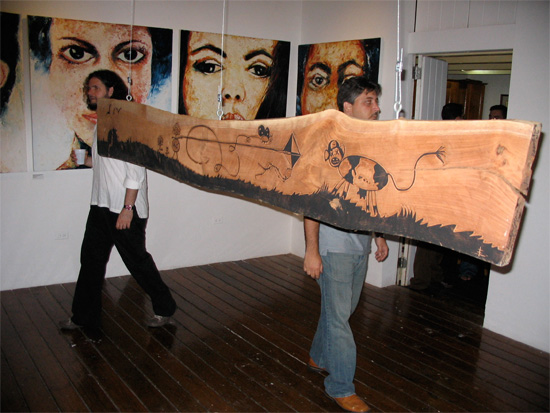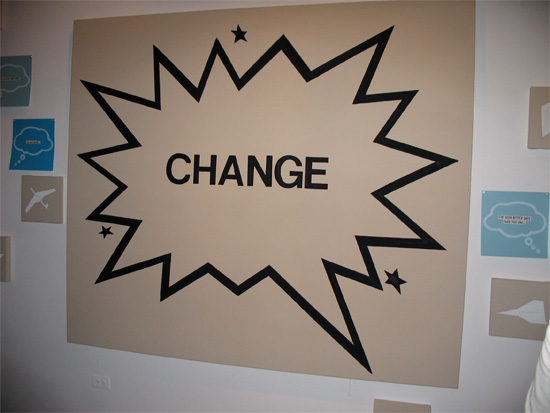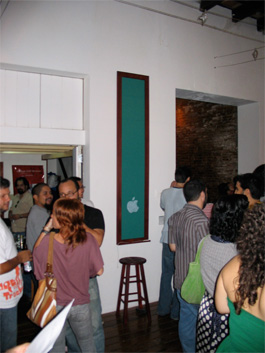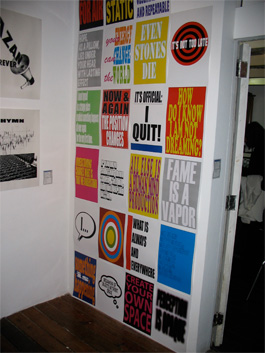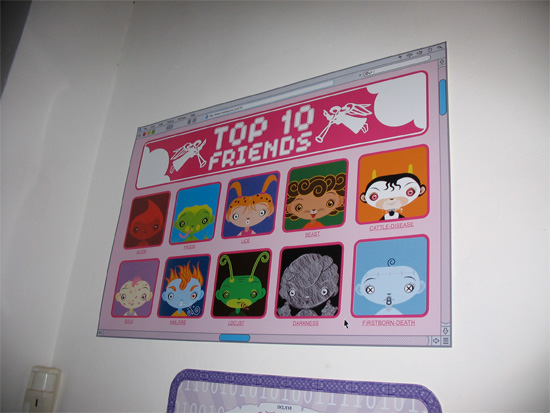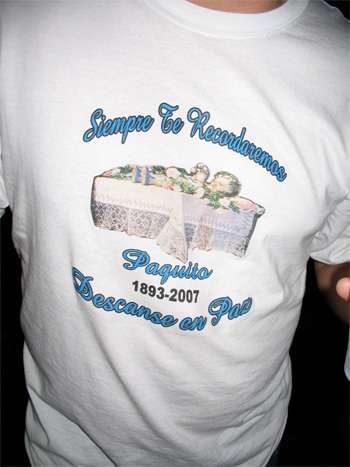|
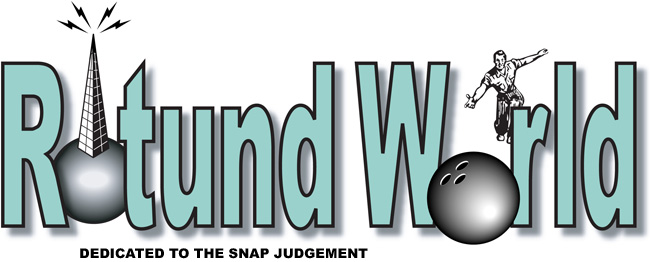
The Hiatus that Was
Well, that was refreshing. At least, it was supposed to be. A several-week hiatus from the exigencies of writing about the artworld and its seething demimonde of wheedling, combustible art mouseketeers, who wouldn’t be rested? Not us, we’ve been staring into the yawning maws of bulging moving boxes, empty bookshelves, tiny, completely inadequate closets, and lopsided, already-icky kitchen shelving until our eyeballs hurt, mopping, dusting, running up and down stairs, grunting and sweating like pigs, trying to settle into apartments in two distant cities as part of a scheme that’s supposed to improve our ever-transitory, fragmented lives. But that’s another island story. Meanwhile we’re lagging far, far behind once more, having missed whole episodes of the artworld’s customary hugger-mugger, in a season that’s supposed to be todo tranquilo mano, the torrid summer months when sensible people are snoozing on the beach or somewhere else altogether, up in Rhode Island or Maine or Nova Scotia. No such luck for us.
So let’s try to redeem ourselves a little, starting on a high note with the latest snazzy curation by Julieta González over at the Berezdivin’s warehouse on Avenida Fernández Juncos, Espacio 1414. González calls this installation from the collection Visiones del paraíso: utopías, distopías, heteropías, and while we sometimes sort of roll our eyes at the jargonward drift of González’s titles, we’re never disappointed at what she puts on the floor. Visiones del paraíso is an unusually well-stuffed outing, a shitload as we like to say, demanding two or three visits at least. There is a lot from the collection’s almacén we’ve never laid eyes on—like the high ledge sporting space-age-looking doodads, Architectural Shelf by Chad Meroni (mixed media, dimensions variable, 2005) and Sam Durant’s excellently tart Landscape Art Sign (Emory Douglas), a 50" x 29-7/8" x 9" light box from 2007—plus a sprinkling of golden oldies, including one of our faves in the collection, Carlos Garaicoa’s night-city-on-a-bookshelf, You Can Build Your Own City at Your Own Risk (mixed media, dimensions variable, 2001), last seen in the superb light-installation exhibition González mounted last year. Personally, we never tire of what González cooks up, no matter that themes like globalización and utopía have been knocking about the international ether for awhile. The curator has a knack for taking the basically idiosyncratic shopping habits of her employers —in this case the collectors of contemporary art Diana and Moises Berezdivin—and turning this individualistic pastime into coherent, revealing, and often quite handsome panoramas of what is happening at the moment, more or less, at a certain level of artworld creation. It’s a very good trick because it relies so heavily on the whims of other people and attempts to reflect on a deeply intellectual revolú without being boring boring boring, over people’s heads, or otherwise so off-putting you just want to spit. For isle art-makers, connoisseurs, or anyone here who pretends to be interested, it’s not just entertaining, it’s an important opportunity to see what’s possible art-wise at the highest levels, as a means to contrast, compare, and so forth, the usual school-book stuff that, nonetheless, so often escapes us in our tropical dream-state. This is not to say or even remotely imply there isn’t an unusual amount of savvy work being done in Puerto Rico, owing no doubt to all that island-continent hopping to and fro, not to mention native genius, no no no. But do we see scads of international contemporary work in the museums, commercial galleries, or so-called alternative spaces? We do not. With the exception of a few far-seeing individuals, like art dealer Walter Otero, we rely on the distinctly money-driven art fairs and the internationally focused magazines that dribble into the island’s handful of otherwise obnoxious Borders Bookstores and are pounced upon like so much zebra flesh by artworld lions and lionesses. (We want to plug la Escuela de Artes Plásticas in this regard, who, we understand, trucks some lucky students every spring to the least egregiously money-grubbing art fair in the world, Madrid’s ARCO.) So the business of having so much to look at is, in our view, one of the most likable traits of Visiones del paraíso. Too much, in fact, is never enough. As in a George Orwell or Aldous Huxley mid-twentieth-century dystopian novel, or Terry Gilliam’s searing, eerily prescient cinematic downer, Brazil, the idea comes through clearly enough by accretion that the future, as seen from here, does not look so hot. Or said another way, the scary future can be a fine instrument with which to palpate the grim here and now.
Michael Rokowitz’s Scheme 23A (drawings and cigar-box sculpture, dimensions variable, 2006) is one of the exhibition’s best examples of how a grand visionary scheme gets run over by the vicissitudes of history. Rokowitz does a nice, minimal job of telling a story that needs not a whisper more of irony than it has in life to capture the gargantuan folly into which our fondest hopes descend. Dig Che’s weird permutation of the chestnut about dying on one’s feet and living on one’s knees; but perhaps weird only from the perspective of more than four decades.
Durant’s lightbox serves as both a pithy tribute to a gnarlier epoch—the Emory Douglas of the title was the storied Black Panther Party’s brilliant graphics guy, a propagandist of a finely calibrated sense of the moment—and a good, sharp poke in the ribs for a time which continues to value fame, riches, and grandiosity over any social good or purely artistic achievement. Other standouts in the exhibition: the wretched beauty of Kendall Greers’ T.W. Batons (Circle) (22 police batons, dimensions variable, 1994) side by side with Gardar Eide Einarsson’s In the Name of the Law (acrylic on canvas, wooden blocks, 62" x 48" x 13", 2006), works whose formal exquisiteness manages to invoke wariness, alarm, even disgust. Nearby is a work you have to read to really get: Thomas Hirschhorn’s treatise on anarchy, Abstract Relief (Total Liberty) (printed matter, paper, plastic, aluminum foil on wood, 74-3/4" x 118-1/8" x 19-5/8", 2000). Sergio Vega is another necessarily readable artist, who loves to pry into the fevered imaginings of humans on the march. His A Summer Garden (mixed-media installation, dimensions variable, 2002) is an inquiry into how the Old World views the New, and it’s a fairly typical Vega work, involving a breezy element —this time it’s live palm trees, in one piece he employed a working toy train set—in combination with some heavy slogging through found, altered texts. Also worth spending the considerable effort it takes to view, Dan Graham’s fascinating video meditation on the doomed fervor of mid- and late-twentieth-century rock aesthetics, Rock My Religion, a video from 1982 which clocks in at more than 55 minutes and features performances by heart-breakingly young rock deities Jim Morrison and Patti Smith. Whatever the exhibition’s intrinsic fascinations, we’re convinced that a regular visit to Espacio 1414 promises a good time and a healthy complexion. Partaking in neat arrangements of very good contemporary art is a bracing tonic against woozy practice and narrow thinking, which, we’re loathe to admit, we’ve caught a whiff or two of hereabouts. Not from you, of course. Espacio 1414 is centrally located at Fernández Juncos #1414 in Santurce, and it usually pays to call González to inquire about the status of the collection: open or shut. Her number is 787-725-3899, and she can also be contacted by email here. Images from the top of this section down: first, a detail from Scheme 23A. Next, Garaicoa’s You Build Your Own City . . . with Meroni’s Architectural Shelf, plus a closeup of the latter. Below that, Sam Durant’s Landscape Art Sign . . . , please excuse the shine. Next, an installation shot and another detail from Scheme 23A. Next, on the left, Greers’ T.W. Batons . . . and on the right Einarsson's In the Name of the Law. Below that is Hirschhorn's Abstract Relief . . . and Vega's A Summer Garden.
Neither woozy practice nor narrow thinking figure significantly in the exertions of the =Desto crew, as far as we can tell. The tiny Santurce space has consistently been home to activities high in the groove factor, the most recently groovy of which was Kristine Serviá’s wide-ranging, spot-on gathering of artistic ephemera and those who produce it, Pública. After a little hiatus of their own, the =Desteños have given the space over to a seemingly miscellaneous exhibition, but one which, if read in the proper light, coheres around the show’s title, Feria.
It could be argued that at least some of the work has to do with consumerism and the commercial impulse. But then, what artwork worthy of its name doesn’t these days? No matter. With or without a theme, Braulio Espinosa Castillo has hit upon a winning and highly contemporary concept under the rubric Product? Inc. His installation at CIRCA 2007, a vitrine in which artists posed like department store fashion dummies for breathtakingly long stretches of time, was the hit of the art fair’s independent artist’s projects. At the =Desto opening, Espinosa Castillo presented a video of his own visage intoning a litany of product-like accomplishments—“In 1990 [or whatever year it was] we were product tested”—while offering a full 360 of his almost burnished dome and fearsome mien. Better yet, there was the man himself with a barcode shaved into the hair on the back of his head. You might call it an art school trick, but we liked it very much for the uncanny juxtaposition of real guy and eerily identical virtual image.
Nathan Budoff has always been for us a talented painter of rather enigmatic narrative proclivities, whose canvases are stuffed with such a variety of references and styles that in many cases we aren’t sure what we’re supposed to be seeing, no matter how much we like what we’re looking at. This all-over-the-placeness makes his three Feria paintings all the more surprising because they are, above all, and perhaps more than anything else in the exhibition, focused on an old-fashioned idea about suburbia and its discontents. It is as if after a period of wandering about the Caribbean in a heat-induced swoon, the artist made his way back to cooler, more familiar surroundings, which, it appears, he regards with open contempt. The paintings are not exactly dripping with sardonic commentary, but they offer a deadpan view of the landscape and its inhabitants which can only be described as mordant. These paintings are even more likable than usual, and the patriotically themed Summer Weekend is a veritable dynamo of not altogether agreeable psycho-sexual energies.
For a man who says that his paintings, of which he claims not to be fond, exist solely as illustrations for other, usually larger works, Karlo Ibarra is showing a lot of pigment slathered on canvas these days, as he does in Feria. Rafael Miranda, on the other hand, offers a video on the inside of the space and a honking big PVC thingie on the out. We suggest you drop in on Jason (Mena), Omar (Obdulio Peña Forty), and Raquel (Quijano) and see what’s on their walls. =Desto is located not far from the Berezdivin’s, on Américo Salas at Hipódromo, and a phonecall to 787-633-3381 will likely yield beneficial results. Tell them Rotund World sent you. Watch out for clowns in the vicinity. Really. Images in this section begin at the top with the sculptural part of an installation which includes video—shown in the last photo in the series—by Rafael Miranda. Second and third from the top feature the Feria edition of Espinosa Castillo’s Product? Inc, including a shot of the artist himself. Below that, the three paintings in the exhibition by Nathan Budoff. The Beat Goes On
If Julieta González has been steadily consolidating her vision of what she can do with the Berezdivin’s warehouse of miscellany, the folks at Galería Candela have a ways to go. You have to applaud Abdiel Segarra, the curator of the madcap series of exhibitions that Candela embarked on at the beginning of summer, at a killing pace of one show every two weeks. We spoke to Candela’s owner and collaborator in the art projects, Pablo Rodríguez, about our misgivings, and he pointed out that though the openings are a party and he manages to bring some collectors in during each show’s first few days, no one comes to the space for the duration of the exhibition. It’s an understandable dilemma, but one which tends to perpetuate itself. It appears to us that Rodríguez doesn’t really want to be in the business of selling art. Beyond the posters, pamphlets, t-shirts, and buttons which he and Segarra prepare for opening night, there is not much effort to establish the space’s identity: no set hours, no staff, no way, except for a very good web page, to know what’s going on between opening nights. Rodríguez believes he can turn the art he exhibits into product—those t-shirts, for example—and sell such chotchkies at art fairs to support the Candela project. Mainly, he says, the idea is to provide exhibition opportunities for young, unexposed artists, and to show the customarily easy-going island artworld how things really get done. If you’ve always assumed that the point of making art is to sell the art while precisely not turning it into product, at least in terms of building a career, it’s important to know that although Rodríguez has a long-standing interest in visual art, he’s always been a maverick about it. Over the years he’s put on shows when he felt like it—for Dzine, Lee Quiñones, and Sofía, among others—and until now he’s been more interested in producing music. This goes a long way toward explaining the breakneck pace and the party favors at Galería Candela openings.
To date there have been four one- and two-person shows in the space since the beginning of summer: a drippy, fleshpot painting-installation exhibition by Roberto Márquez, a comix-inspired ceramic figure and codex extravaganza by Miguel Rivera, a show of paintings, drawings, prints, and sculptures by the perpetrators of the web magazine Trance Líquido, Lilliam Nieves and Daniel A. Román, and a floor-to-ceiling painting, drawing, and video exhibition by two of the most interesting non-painters among the young and restless, Karlo Ibarra and Héctor Madera González. There was also one wide-ranging, conscientiously thought-out group show, BLOG, whose bold aim was, according to organizers Tito and Nani Fernández, to “reinterpret the narrative’s reality.” The atmosphere at the openings has varied from electric to humdrum and the art has always been more or less what we expected, but it’s been hard for us to determine if the cumulative effect of so much so quickly is, as Rodríguez hopes, to draw larger and ever more curious crowds to the fray. None of the artists has complained about the pace of things. On the contrary, everyone we talked to seems to think the idea is hunky-dory, and why would we ask?
Well, to begin with, looking at art is, for us, a meditative experience. What we want to see we want to return to, and the value of doing this quickly and with all the accouterments of a pop record release is somewhat lost on us. True, it’s been awhile since exhibitions at galleries meant anything significant for anyone but the artist, the artist’s friends and family, and the whole movable feast of opening-night revelers. Whatever art gets sold probably sells at what in some places are called preview nights, prior to the openings, or in the first frenzied hours of art fairs or through a dealer’s extra-curricular activities. So in a sense Rodríguez is correct to think of the shows at Candela as “auditions,” as he once put it, for fairs he might attend in the future or bigger shows he might put on elsewhere, especially when there’s a single artist involved who otherwise would have no show at all. But BLOG was a telling exception. It was a show with more or less intriguing works—we especially liked Kristine Serviá’s snapshots of shaped and measured nothingness, Miguel Ángel Torres Aponte’s too-tall-to-be-useful blackboard, and W&N’s riotous mapping of the homophobic inclinations of royalty—but its ambitions were what really set it apart. More than cash-bearing bodies coming through the door, BLOG needed some time to comprehend its reach, and more time to appreciate it.
As for what lessons these two-week shows impart, we would imagine that Candela Standard Time (CST por sus siglas en inglés) implies, to any young artist paying attention, that the increasingly frantic dynamic of making and exhibiting work, so driven in the real world by the strictly monetary imperatives of art fairs and other market forces, is the order of things beyond the art school studio door, a kind of natural law by which the formal and social concerns that were once essential elements of creative production are old school and outmoded; that creation’s no longer much the point at all. When Rodríguez waxes enthusiastic about making t-shirts out of some of the admittedly graphically spiffy paintings on the wall, he might just be saying that to watch the steam come out of our ears and our eyeballs rachet out of their sockets, but we believe he believes what he says. It’s a mantra that seems to us about 180 degrees off, but we’ve been wrong before. In fact we like the project overall, it’s fun to be part of the artmob in a relatively new and—even if a little clockwork—bohemian setting, it’s smashing that Rodríguez and Segarra are providing young artists with shows, and sometimes the mood is transcendent. If the boys altered the script just slightly—a couple of extra weeks for exhibitions, hours for the gallery beyond opening night, however limited—they’d probably hear less Rotund grumbling. The first image in the last section shows a detail of the Robert Márquez installation at Candela, Solito Show. The second image is from Miguel Rivera’s ¡Qué clase de héroe! Third down is from opening night at the Comua exhibition, with work by Daniel A. Román in the background and Lilliam Nieves in front. Below that is one of Hector Madera González's paintings from the most recent exhibition in the space, and the following are, on the left, Miguel Ángel Torres Aponte’s installation and, on the right, Jason Mena’s, from the group show BLOG. Also from BLOG, a detail of the work of José Tomas. The t-shirt worn by none other than Rafael Miranda is his own work, and may or may not be what Pablo Rodríguez has in mind. Whatever the case, we love it and want camisas all around. Upcoming, as if all this blather was not enough, Rotund World would love to weigh in on Parto, the recent installation by Migdalia Barens-Vera at el Museo de Arte Contemporáneo, and a new show at that evergreen little neck of the woods, La Liga del Arte, called, by our rough translation, Forgive Me, Mom, I’m a Printmaker. There’s little to forgive in this modest demonstration that the venerable Puerto Rican printmaking tradition is alive and very well, thank you. We also hope to check out the nifty Ada Bobonis installation for your delectation, at el Museo de Arte de Puerto Rico. All in good time, folks. Remember these days of Rotunds past? |


